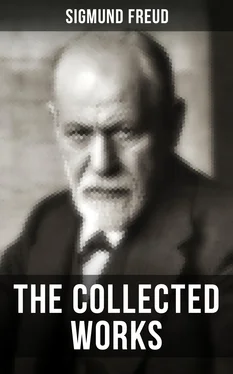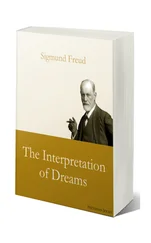We call such a constant relationship between a dream element and its interpretation symbolic . The dream element is itself a symbol of the unconscious dream thought. You will remember that previously, when we were investigating the relationship between dream elements and their actuality, I drew three distinctions, viz., that of the part of the whole, that of the allusion, and that of the imagery. I then announced that there was a fourth, but did not name it. This fourth is the symbolic relationship here introduced. Very interesting discussions center about this, and we will now consider them before we express our own particular observations on symbolism. Symbolism is perhaps the most noteworthy chapter of dream study.
In the first place, since symbols are permanent or constant translations, they realize, in a certain measure, the ideal of ancient as well as popular dream interpretation, an ideal which by means of our technique we had left behind. They permit us in certain cases to interpret a dream without questioning the dreamer who, aside from this, has no explanation for the symbol. If the interpreter is acquainted with the customary dream symbols and, in addition, with the dreamer himself, the conditions under which the latter lives and the impressions he received before having the dream, it is often possible to interpret a dream without further information — to translate it “right off the bat.” Such a trick flatters the interpreter and impresses the dreamer; it stands out as a pleasurable incident in the usual arduous course of cross-examining the dreamer. But do not be misled. It is not our function to perform tricks. Interpretation based on a knowledge of symbols is not a technique that can replace the associative technique, or even compare with it. It is a supplement to the associative technique, and furnishes the latter merely with transplanted, usable results. But as regards familiarity with the dreamer’s psychic situation, you must consider the fact that you are not limited to interpreting the dreams of acquaintances; that as a rule you are not acquainted with the daily occurrences which act as the stimuli for the dreams, and that the associations of the subject furnish you with a knowledge of that very thing we call the psychic situation.
Furthermore, it is very extraordinary, particularly in view of circumstances to be mentioned later, that the most vehement opposition has been voiced against the existence of the symbolic relationship between the dream and the unconscious. Even persons of judgment and position, who have otherwise made great progress in psychoanalysis, have discontinued their support at this point. This is the more remarkable since, in the first place, symbolism is neither peculiar to the dream nor characteristic of it, and since in the second place, symbolism in the dream was not discovered through psychoanalysis, although the latter is not poor otherwise in making startling discoveries. The discoverer of dream symbolism, if we insist on a discovery in modern times, was the philosopher K. A. Scherner (1861). Psychoanalysis affirmed Scherner’s discovery and modified it considerably.
Now you will want to know something of the nature of dream symbolism, and to hear some examples. I shall gladly impart to you what I know, but I admit that our knowledge is not so complete as we could desire it to be.
The nature of the symbol relationship is a comparison, but not any desired comparison. One suspects a special prerequisite for this comparison, but is unable to say what it is. Not everything to which we are able to compare an object or an occurrence occurs in the dream as its symbol; on the other hand, the dream does not symbolize anything we may choose, but only specific elements of the dream thought. There are limitations on both sides. It must be admitted that the idea of the symbol cannot be sharply delimited at all times — it mingles with the substitution, dramatization, etc., even approaches the allusion. In one series of symbols the basic comparison is apparent to the senses. On the other hand, there are other symbols which raise the question of where the similarity, the “something intermediate” of this suspected comparison is to be sought. We may discover it by more careful consideration, or it may remain hidden to us. Furthermore, it is extraordinary, if the symbol is a comparison, that this comparison is not revealed by the association, that the dreamer is not acquainted with the comparison, that he makes use of it without knowing of its existence. Indeed, the dreamer does not even care to admit the validity of this comparison when it is pointed out to him. So you see, a symbolic relationship is a comparison of a very special kind, the origin of which is not yet clearly understood by us. Perhaps later we may find references to this unknown factor.
The number of things that find symbolic representation in the dream is not great — the human body as a whole, parents, children, brothers and sisters, birth, death, nakedness and a few others. The only typical, that is, regular representation of the human person as a whole is in the form of a house , as was recognized by Scherner who, indeed, wished to credit this symbol with an overwhelming significance which it does not deserve. It occurs in dreams that a person, now lustful, now frightened, climbs down the fronts of houses. Those with entirely smooth walls are men; but those which are provided with projections and balconies to which one can hold on, are women. Parents appear in the dream as king and queen , or other persons highly respected. The dream in this instance is very pious. It treats children, and brothers and sisters, less tenderly; they are symbolized as little animals or vermin . Birth is almost regularly represented by some reference to water ; either one plunges into the water or climbs out of it, or rescues someone from the water, or is himself rescued from it, i.e., there is a mother-relation to the person. Death is replaced in the dream by taking a journey, riding in a train ; being dead, by various darksome, timid suggestions ; nakedness, by clothes and uniforms . You see here how the lines between symbolic and suggestive representation merge one into another.
In contrast to the paucity of this enumeration, it is a striking fact that the objects and subject matter of another sphere are represented by an extraordinarily rich symbolism. This is the sphere of the sexual life, the genitals, the sex processes and sexual intercourse. The great majority of symbols in the dream are sex symbols. A remarkable disproportion results from this fact. The designated subject matters are few, their symbols extraordinarily profuse, so that each of these objects can be expressed by any number of symbols of almost equal value. In the interpretation something is disclosed that arouses universal objection. The symbol interpretations, in contrast to the many-sidedness of the dream representations, are very monotonous — this displeases all who deal with them; but what is one to do?
Since this is the first time in these lectures that we speak of the sexual life, I must tell you the manner in which I intend to handle this theme. Psychoanalysis sees no reason for hiding matters or treating them by innuendo, finds no necessity of being ashamed of dealing with this important subject, believes it is proper and decent to call everything by its correct name, and hopes most effectively in this manner to ward off disturbing or salacious thoughts. The fact that I am talking before a mixed audience can make no difference on this point. Just as there is no special knowledge either for the Delphic oracle or for flappers, so the ladies present among you have, by their appearance in this lecture hall, made it clear that they wish to be considered on the same basis as the men.
Читать дальше












